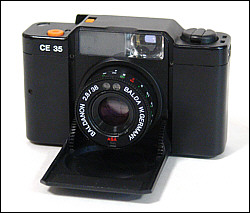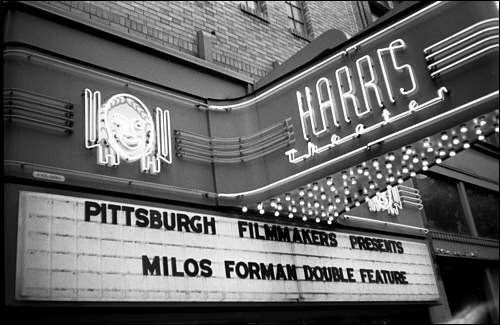Balda CE 35

|
|
|
| Style, film format | Folding 35mm scale focus |
|
|
|
| Lens, shutter | Coated f/2.8 38mm Baldanon (Tessar-type). Electronically controlled program-type leaf shutter. |
|
|
|
| Photo quality | Very good |
|
|
|
| Ergonomics | Small camera that is much like the Minox 35 series. |
|
|
|
The 1970s weren't kind to the West German camera industry, and by the 1980s, there were only a handful of cameras being built there.
One camera that is often overlooked is this little gem: The Balda CE 35. It's one of several models that is based on this design, and if it reminds you of the Minox 35 series, then you probably wouldn't be far off the mark. On a side note, it's interesting how the camera industry generally has refrained from lawsuits involving body and lens design.
This camera is identical to the Voigtlander Vito C. Both cameras come with a dedicated flash that bolts onto the side of the camera. I don't have the flash unit.
The Balda CE 35 is a zone-focus camera produced in the early 1980s that featured a Tessar-type lens (slightly wide angle at 38mm). The camera has program-type autoexposure with no provision for any manual settings, although there is a 2X backlight exposure compensation switch on the top of the camera. It's the small orange tab on the viewfinder housing.
Many of the Balda CE cameras that I've seen pictured on the Internet have this pebble-grain leather-type surface. My camera is smooth, like a Minox.
It's a battery-dependent camera that runs on two S76-type cells. It appears that there is one manual setting, should the batteries fail. It looks to be roughly f/8 or f/11 at 1/60 of a second. That's a guess and not fact.
The camera's ASA range runs from 25 to 1000, which is somewhat unusual. Further, it has no setting for ASA 800, which many photographers have used when pushing Tri-X, although it does have settings for ASA 250 and ASA 500. Well, go figure.
That's enough griping about its features. How is the Balda CE 35 to use?
It's a nice little camera. The upper part of the film advance extends ever so slightly beyond the viewfinder housing, which makes it simple to grasp with a thumbnail. It's a single stroke to wind on to the next frame. The shutter release is where you would expect it, and the shutter releases with an audible click that isn't too loud and doesn't leave you wondering if the shutter actually released.
Should you need flash, a small flash symbol will appear in the viewfinder. If the camera was able to meter the scene within its range, it displays "OK" on the right side in the viewfinder. I don't have the matching flash. I've seen photos of it, and I don't think I would use it. It attaches to the left side, which makes the camera very wide to hold.
The viewfinder displays the framelines, a dotted line for parallax when shooting close ups and pictograms across the bottom to aid focusing. The lens is marked in both feet and meters and is simple to focus. The large translucent window on the front of the camera gathers light to display the framelines and pictograms.
Rewinding takes a conscious effort, because first you must pull up the tip of the rewind crank. It always takes me several tries. Next, you must depress with a thumbnail the very tiny rewind post. After rewinding, pull up slightly more on the crank and the back swings open.
There's really no learning curve with this camera, so the only thing left to do was to shoot with it.
I was pleasantly surprised with the results from the camera. The lens is very good, as you would expect from a Tessar-type optic, and the exposures seem to be right on for nearly all of the shots. There is some vignetting in certain shots, and I have to confess that it's a feature that I'm starting to enjoy.
The Balda CE 35 is a great pocket camera or one that you can stuff quickly into a briefcase, backpack or purse.

Harris Theater, Pittsburgh, 2008
